________________
PHILOSOPHICAL & RELIGIOUS PRINCIPLES 61
All these are primordial and in their essense are unchange
ons can change, in which they manifest themselves.
Consciousness is originally natural to each soul but the material karmas, giving birth to various barriers disturb the finding of real knowledge.
Cognition can be secured by means of feelings, and mind and by means of soul, which has liberated itself from karma (this is the highest form of cognition).*
The soul, having secured the condition of perfection-kevala can cognize the real nature of all things; it can accept everything relatively and conditionally in the remaining steps of path to salvation.
Every affirmation is not absolute but relative and this was given rise by the objective condition of each real existing substance, since with the substance there are two basic groups of indications: unchanged and changing (accidental). All indications exist in reality.
Changing indications are connected with uninterrupted cycle of birth and destruction, while the unchanged indications are the cause of uninterrupted existence of real substance.
All substances, with the exception of time (kala) possess extent in space. Soul is also related to the category of substances, having extent in space, but with the reservation that it exists in it but does not fill it and can be combined simultaneously with other substances (let us say with other soul).
Individual qualities, inherent in every human soul are conditioned by the influence of all karmas on the souls of preceding generations. Dependence on karmas engenders passions, which should be mastered. On this path the competence of the 24 preachers (Jinas)—who are called Tirthankars-boatmen across the current (existence or passions), can be helped. They are called Tirthankars because of this only.
Correct faith, correct cognition and correct conduct are known, because of this, as three jewels (triratna) in the ethics of the Jains.
4. S. Chatterjee & D. Datta, An Introduction to Indian Philosophy, p. 74. 5. Ibid., p. 90. 6. ibid., p. 99.




